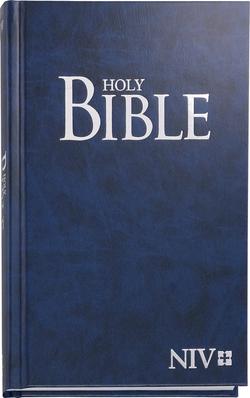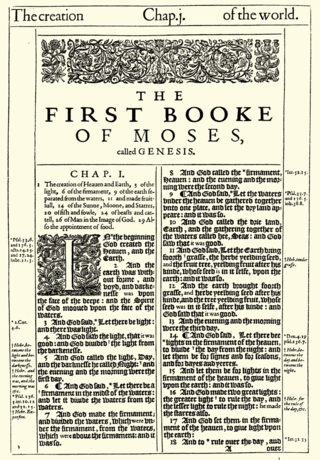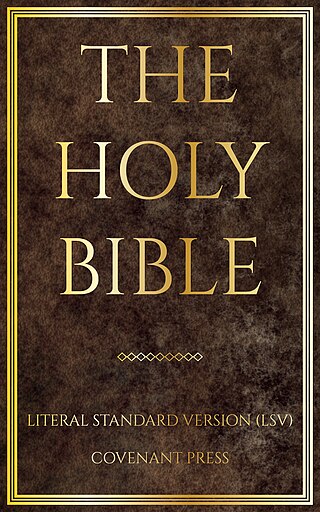Related Research Articles

The King James Version (KJV), also the King James Bible (KJB) and the Authorized Version (AV), is an Early Modern English translation of the Christian Bible for the Church of England, which was commissioned in 1604 and published in 1611, by sponsorship of King James VI and I. The 80 books of the King James Version include 39 books of the Old Testament, 14 books of Apocrypha, and the 27 books of the New Testament.

The New International Version (NIV) is a translation of the Bible into contemporary English. Published by Biblica, the complete NIV was released on October 27, 1978 with a minor revision in 1984 and a major revision in 2011. The NIV relies on recently-published critical editions of the original Hebrew, Aramaic, and Greek texts.

The Septuagint, sometimes referred to as the Greek Old Testament or The Translation of the Seventy, and often abbreviated as LXX, is the earliest extant Greek translation of the Hebrew Bible from the original Biblical Hebrew. The full Greek title derives from the story recorded in the Letter of Aristeas to Philocrates that "the laws of the Jews" were translated into the Greek language at the request of Ptolemy II Philadelphus by seventy-two Hebrew translators—six from each of the Twelve Tribes of Israel.

The New World Translation of the Holy Scriptures is a translation of the Bible published by the Watch Tower Bible and Tract Society; it is used and distributed by Jehovah's Witnesses. The New Testament portion was released first, in 1950, as the New World Translation of the Christian Greek Scriptures, with the complete New World Translation of the Bible released in 1961.

The Bible has been translated into many languages from the biblical languages of Hebrew, Aramaic, and Greek. As of November 2024 the whole Bible has been translated into 756 languages, the New Testament has been translated into an additional 1,726 languages, and smaller portions of the Bible have been translated into 1,274 other languages according to Wycliffe Global Alliance. Thus, at least some portions of the Bible have been translated into 3,756 languages.

The King James Only movement asserts that the King James Version (KJV) of the Bible is superior to all other English translations of the Bible. Adherents of the movement, mostly certain Conservative Anabaptist, traditionalist Anglo-Catholic, Conservative Holiness Methodist and Independent Baptist churches, believe that this text has been providentially preserved as a perfect translation of the Bible into English.
More than 100 complete translations into English languages have been produced. Translations of Biblical books, especially passages read in the Liturgy can be traced back to the late 7th century, including translations into Old and Middle English.

The New Living Translation (NLT) is a translation of the Bible in contemporary English. Published in 1996 by Tyndale House Foundation, the NLT was created "by 90 leading Bible scholars." The NLT relies on recently published critical editions of the original Hebrew, Aramaic, and Greek texts.

Modern English Bible translations consists of English Bible translations developed and published throughout the late modern period to the present.

The Recovery Version is a modern English translation of the Bible from the original languages, published by Living Stream Ministry, ministry of Witness Lee and Watchman Nee. It is the commonly used translation of Local Churches (affiliation).
The Julia Evelina Smith Parker Translation is considered the first complete translation of the Bible into English by a woman. As of 2017, she is still the only woman to have translated the entire Bible unaided. The Bible was titled The Holy Bible: Containing the Old and New Testaments; Translated Literally from the Original Tongues, and was published in 1876.
In semantics, the best-known types of semantic equivalence are dynamic equivalence and formal equivalence, which employ translation approaches that focus, respectively, on conveying the meaning of the source text; and that lend greater importance to preserving, in the translation, the literal structure of the source text. Nida formulated the distinction originally in relation to Bible translations.
Green's Literal Translation or the Literal Translation of the Holy Bible (LITV) is a translation of the Bible by Jay P. Green Sr., first published in 1985. The LITV takes a literal, formal equivalence approach to translation. The Masoretic Text is used as the Hebrew basis for the Old Testament, and the Textus Receptus is used as the Greek basis for the New Testament. This translation is available in book form and is freely available online for use with the e-Sword software program. Some also refer to it as the "KJ3" or "KJV3".
There have been various debates concerning the proper family of biblical manuscripts and translation techniques that should be used to translate the Bible into other languages. Biblical translation has been employed since the first translations were made from the Hebrew Bible into Greek and Aramaic. Until the Late Middle Ages, the Western Church used the Latin Vulgate almost entirely while the Eastern Church, centered in Constantinople, mostly used the Greek Byzantine text. Beginning in the 14th century, there have been increasing numbers of vernacular translations into various languages. With the development of modern printing techniques, these increased enormously.
Messianic Bible translations are translations, or editions of translations, in English of the Christian Bible, some of which are widely used in the Messianic Judaism and Hebrew Roots communities.
There have been several Bible translations into Afrikaans, a language primarily spoken in South Africa and Namibia. The South African Bible Society released full Afrikaans Bibles in 1933, 1953, 1983, and 2020. Other full translations include Die Lewende Bybel (1982), the Nuwe Wêreld-vertaling van die Heilige Skrif (2001), Die Boodskap (2002), the Nuwe Lewende Vertaling (2006), Pad van Waarheid tot die Lewe (2016), and Contemporary Afrikaans Bible (2023). In addition, several individual books were translated into Afrikaans between the 1880s and the 1920s. This was as opinion had started to change that Afrikaans had become a language in its own right separate from Dutch; prior to that, the Dutch Statenbijbel had been used instead.

Sacred Name Bibles are Bible translations that consistently use Hebraic forms of the God of Israel's personal name, instead of its English language translation, in both the Old and New Testaments. Some Bible versions, such as the Jerusalem Bible, employ the name Yahweh, a transliteration of the Hebrew tetragrammaton (YHWH), in the English text of the Old Testament, where traditional English versions have LORD.
The Lexham English Bible (LEB) is an online Bible released by Logos Bible Software; no printed copy is available. The New Testament was published in October 2010 and has an audio narration spoken by Marv Allen. It lists as General Editor W. Hall Harris, III. The Old Testament translation was completed in 2011.

The Literal Standard Version (LSV) is a Modern English translation of the Bible with a number of distinctive features. It describes itself as the most literal translation of the Bible into the modern English language. The first edition was published on February 2, 2020.
References
- 1 2 3 "Holy Bible : Modern Literal Version". Christianlibrary.org. Retrieved 2015-03-30.
- ↑ "The MLV Bible Accuracy Chart" (PDF). Modern Literal Version. 2012-10-01. Retrieved 2024-01-23.
- ↑ Preface, Modern Literal Version
- ↑ "The Bible Reader's Museum". Biblereadersmuseum.com. Archived from the original on 2015-05-03. Retrieved 2015-03-30.
- 1 2 "Modern Literal Version - The Open Bible - The World's Most Accurate English Translation". Christianlibrary.org. Archived from the original on 2015-03-30. Retrieved 2015-03-30.
- ↑ "Modern Literal Version - 2014.1 Beta Update". Churchesofchrist.net. Retrieved 2015-03-30.
- ↑ "Home". e-Sword.net. Archived from the original on 2015-04-01. Retrieved 2015-03-30.
- ↑ "e-Sword Downloads - Commentaries, Dictionaries, Bibles, Devotionals, and add-ons : Stats". Biblesupport.com. Retrieved 2015-03-30.
- ↑ "MySword - Free Android Bible". Mysword.info. Archived from the original on 2015-03-28. Retrieved 2015-03-30.
- ↑ "Bibles". Biblesupport.com. Retrieved 2015-03-30.
- ↑ "Top 500 theWord Downloads". Wordmodules.com. Retrieved 2015-03-30.